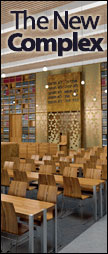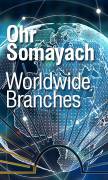Behaaloscha: Chew That
The contextual hook for this week’s essay relates to a scene from Parashat Beha’alotcha of physical indulgence gone awry. When the Israelites complained about their monotonous manna diet and begged Moses for meat, Hashem responded with a miraculous storm of slav birds (often identified as quail) from which the Jews were allowed to partake. Yet, while the meat was still “between their teeth” (Num. 11:33), a divine plague struck down many of those who had feasted on the fowl treat. This haunting image of a divine plague arriving post-mastication serves as our point of departure for exploring two words in Rabbinic Hebrew that refer to the act of “chewing/masticating”: kesisah (the verbal noun for koses) and le’isah (the verbal noun for lo’es). As always with this series, we take two similar Hebrew words that seem synonymous, and try to tease out their subtle differences in connotation and/or etymology. And the case in question is a fascinating instance of nuanced synonymy in Hebrew that has not been widely explored.
At the very beginning we should note an unusual lacuna in Biblical Hebrew: there is no single word that explicitly means “chewing.” Indeed, even the iconic Biblical phrase "chews its cud" (ma’aleh geirah) used in the context of identifying kosher animals (Lev. 11:3–7, Deut. 14:6–8) literally means “brings up the cud” — not chewing, per se. Thus, the verbs koses and lo'es are both Rabbinic Hebrew terms for “chewing,” yet neither term appears in the Bible.
The Talmud (Brachot 37a) uses the verb koses to describe how one who “chews” raw wheat or rice should recite the blessing borei pri ha'adamah, rather than bore minei mezonot. Likewise, the Tosefta (Brachot 4:6–7, cited in the Talmud there), uses the verb koses when stating that one who “chews” wheat or rice should recite bore minei zeraim (an opinion that is not accepted in Halacha). Similarly, elsewhere, the Mishnah (Nedarim 6:10) and Tosefta (Nedarim 3:7) discusses whether a person who has foresworn tasting wheat is only prohibition from eating regular wheat-based goods, or is even forbidden from simply “chewing” (la’chus) raw wheat.
The Talmud (Brachot 36b, Yoma 81a) uses the term kas to describe a person “chewing” pepper or ginger on Yom Kippur (which, according to Rava, is not Biblically considered "eating" on Yom Kippur as long as the pepper or ginger was dry). Likewise, Abaye describes himself as being so hungry after a lavish meal that he was ready to eat [koses] the plate on which the food was served (Megillah 7b). In that context, Rashi (to Megillah 7b) explains that the term kesisah refers to any abnormal or non-standard way of eating something (see also Maharasha there who suggests that perhaps the plate in question was made of something edible).
The Talmud (Ketubot 77a) relates that one time, Rabbi Elazar said a Halachah with which Shmuel disagreed, and Shmuel commented that Rabbi Elazar should be fed barley like an animal because there is no substance to the ruling he relayed. In relating this anecdote, the Talmud uses an inflection of koses to denote giving Rabbi Elazar food to eat, and Rashi (there) explains that anytime one eats in an unnatural way, that act is called koses. Rashi repeats this assertion about kas/koses in a few other places (to Brachot 36b, Yoma 81a, Chullin 15a).
In another context, Rashi offers a slightly different definition of koses: the Talmud (Beitzah 26b) attempts to bring a proof that something cannot become muktzeh for only part of a day from the fact that on Yom Tov one may cook lentils and beans. Before one put them into a pot of boiling water, those legumes were suitable for consumption by way of koses, but once they are put into boiling water they seemingly become muktzeh (because they cannot be eaten while boiling hot) and yet after they are cooked and have cooled down, they revert to their non-muktzeh status. While the Talmud ultimately rejects this proof, Rashi nonetheless explains that any food that can be eaten raw, when one does so, this act is called koses.
Several philologists like Dr. Asher Weiser and Rabbi Yaakov Yehudah Zilberberg (Di Kasif) connect the Rabbinic Hebrew root KAF-SAMECH-SAMECH with the Biblical Hebrew root KUF-SAMECH-SAMECH, which appears once in the context of “cutting down/destroying” (yikoses) the fruits of a metaphoric tree (Ezek. 17:9). Rashi (to Ezek. 17:9) connects KUF-SAMECH-SAMECH with the root KUF-TZADI-TZADI (kotzetz, “cutting”) based on the interchangeability of SAMECH and TZADI, while Mahari Kara (there) connects KUF-SAMECH-SAMECH with the root KAF-TAV-TAV (kotet, “smashing”), based on the interchangeability of KUF and KAF and the interchangeability of SAMECH and TAV. Turning to the classical lexicographers, the triliteralist lexicographers like Ibn Janach and Radak see that root of yikoses as triliteral (KUF-SAMECH-SAMECH), while the biliteralist Menachem Ibn Saruk (in Machberet Menachem) sees the root as the two-letter string KUF-SAMECH.
Implicitly following that latter approach, Rabbi Shlomo Pappenheim in his biliteralist work Cheshek Shlomo discusses the two-letter root KUF-SAMECH, whose core meaning he defines as "a cut tube." The way he sees it, the term Biblical yikoses focuses on the "cutting" aspect of that meaning. Other words that he connects to this root focus on the tubular aspect of the root, including keset ("pen/stylus," see Ezek. 9:2, 9:11), kesem ("magic stick/wand" or magical writings written with a keset), and kisam ("toothpick"). Those words refer to tubes cut along their length. The Shulchan ("Table") in the Tabernacle/Temple has kesavot (Ex. 25:29, Num. 4:7) which were tubes cut along their width upon which the shewbread rested. Rabbi Pappenheim also sees the Biblical Hebrew word kaskeset (“scales” used to identify kosher fish, or “dandruff” in Modern Hebrew) as also related to this root.
An inflection of the terms kesisah/koses is the Hebrew kaskasa ("crunch" or "crush with one's teeth"). Interestingly, the poem Elohei Ha’Ruchos (recited in some communities on Shabbat HaGadol) written by Rabbi Yosef Tuv-Elem of Bonfils states that on Passover night, one must do kiskusei to their maror. The Ohr Zarua (Hilchot Pesachim §256) offers an elucidation of that piyyut in which he explains that kiskusei means “munching/chewing,” which suggests that one cannot just swallow the maror without first chewing it to experience its bitter taste. On the other hand, Rabbi Shamshon Raphael Ortzel of Bayit Ve’Gan suggests that perhaps kiskusei in this context means “(vigorous) shaking” (like it does in Shulchan Aruch Orach Chaim §651:9 in the context of shaking a lulav) to mean that one must shake off the charoset before eating the maror. Indeed, the verb l’kaskes appears in the Mishnah (Niddah 9:7) in reference to “vigorously rubbing” a fabric as part of the laundering process. Perhaps this action resembles “chewing” with its consistent forceful movement.
Looking at the origins of kesisah/koses, Rabbi Ernest Klein (no relation) traces these terms all the way back to the Akkadian words kasasu ("cutting into pieces") and kissatu ("fodder"). The way he sees it, they are related to Arabic cognate that mean "pounding/grounding/pulverizing." I have even seen it claimed by one Dr. A. Weiss (writing in YU's rabbinic journal Chorev in 1943 vol. 7, p. 55) that the first word in the Rabbinic Hebrew phrase kos shel akarin in reference to a type of “contraceptive” refers not to a kos in the sense of "cup," but to a cognate of koses in the sense that the ingredients used in this concoction were “cut up” or “chopped up” into small bits and mixed together.
Interestingly, the French word couscous (from Arabic kuskus) refers to a specific type of food made up of small bits of pounded grain. The word is also cognate with the Rabbinic Hebrew koses because it describes chopped up grains that appear as though they are pre-chewed. Yet, this has no connection to the English word kasha (“buckwheat”). That word actually derives from Slavic languages (like Russian and Czech) by way of Yiddish — although in those Slavic languages it originally meant "groats/cereal/porridge," and not specifically buckwheat.
The philologist Samuel Krauss links the root KAF-SAMECH-SMAECH to the root AYIN-SAMECH-SAMECH (assisi, “juicy”), possibly because when one chews a foodstuff, this releases its inner juices and allows one to experience those savory flavors.
Another form of kesisah/koses appears in the Targum. When the Bible uses the Hebrew word nikkudim )Jos. 9:5, 9:12, I Kgs. 14:3) to refers to food provisions, this word is translated into Aramaic by Targum as kasnin. In fact, baked goods like cakes and other pastries on which one might recite mezunot are known as pat haba’ah b'kisnin (see Brachot 42a).
Radak (to I Kgs. 14:3) relates the term kisnin to koses by explaining that kisnin are the sorts of treats on which one might “munch” during a party (or wedding). Comparable definitions of pat haba’ah b'kisnin as the type of snack people eat at a party can be found cited in the name of Rrabbeinu Chananel (Ohr Zarua Hilchot Brachot §149) and Rabbi Hai Gaon (Sefer Ha’Ner to Brachot 42a). Finally, Rabbi Moshe Tedeschi-Ashkenazi (Ho’il Moshe to I Kgs. 14:3) suggests that this word is cognate with koses (which refers to using chewing something into smaller pieces) because kisnin refers to a foodstuff which can crumb and therefore break down into smaller pieces.
The term le’isah appears thrice in the Mishnah: the Mishnah (Shabbat 19:2) states that one may put ground cumin on a circumcised baby's member on Shabbat for healing purposes, and that if one did not ground the cumin before Shabbat, one may even chew [lo'es] whole cumin with his teeth so that it could be put on the child's member. This verb again appears in the context of preparing grits for use in a cleaning agent to remove blood stains (Niddah 9:7).
In the third case, the Mishnah (Pesachim 2:7) rules that one may not chew (lo’es) wheat on Passover to turn it into a gauze/bandage to place on one’s wound because this will cause the wheat to become chametz. In that context, Rashi (to Pesachim 39b) defines lo’es as koses. Likewise, the Talmud (Brachot 44b) states that eating spleen is good for one's teeth, but bad for one's intenseness. Because of this, the Talmud recommends chewing the spleen, but then spitting it out instead of swallowing it. The verb used there to denote “chewing” is an inflection of lo'es, and Rashi (there) again comments that loe'es means the same thing as koses.
The Mishnaic Hebrew term lo’es has cognates in Aramaic/Syriac wherein the three-letter root LAMMED-AYIN-SAMECH also means “chewing/masticating.” It even appears in Targum (to Ecc. 12:3). But the etymology of this term is otherwise obscure. Rabbi Avi Kobernick in Hipuch Otiyot offers a speculative approach that views LAMMED-AYIN-SAMECH as a metathesized form of the Hebrew root SAMECH-LAMMED-AYIN (sela, “rock/boulder,” see my earlier essay “Like a Rock,” Nov. 2018). Just as the sela represents a strong, durable mineral that cannot easily be broken, so does lo’es represent the polar opposite: the breaking down of some food by chewing it with one’s teeth.
Perhaps instead of treating the pair of terms that we have presented as synonyms that need differentiation, we ought to look to their respective etymologies and notice that they are of different origins: koses/kesisah seems to be a native Hebrew word, while lo’es/le’isah seems to be a Hebrew loanword borrowed from Aramaic. So both terms could mean the same thing, but since they come from different languages, their synonymity does not point to any superfluity.
Yet, despite their apparent synonymy, members of the famed Mazuz family from Tunisia seem to presume that there is some nuanced semantic difference between the types of “chewing” implied by the terms lo’es/le’isah and koses/kesisah. Although it is hard to substantiate this difference or even understand exactly what it means, this understanding is evident in three works:
Firstly, responsa Ish Matzliach (vol. 2 Orach Chaim §47) by Rabbi Matzliach Mazuz contains a lengthy discussion of whether the term pilpel refers to a “common pepper,” “black pepper,” or both. In that context, he discusses how the use of the term kas — with a cognate of koses instead of lo’es — in the reference to chewing a pilpel on fast day might have a bearing on that discussion.
Secondly, Rabbi Matzliach Mazuz’s son Rabbi Meir Mazuz (Arim Nissi to Pesachim 39b) writes that le’isah typically implies chewing something as part of eating it (i.e., in preparation to swallowing it), while kesisah does not necessarily bear that implication. Because of this, he explains that when Rashi explains le’isah as referring to koses (in the context of chewing wheat to create a bandage), Rashi’s point was that the person chewing the wheat on Passover was not doing do in order to swallow it, but simply in order to soften/wet the grain so it can be used as part of the dressing for one’s wound.
Thirdly, Rabbi Moshe Isserles (in his glosses to Shulchan Aruch Orach Chaim §567:3) writes that on fast days (except for Yom Kippur), one may chew cinnamon sticks or other unpulverized spices in order to "wet one's throat" — as long as one spits it out and does not swallow it. In that context, Rabbi Isserles uses the word lo’es, following the Tur (there). However, the source for this ruling, the Ravyah (Hilchot Taanit §861) actually uses the word la'chus (an infinitive form of kesisah), not lo'es. Rabbi Yitzchak Barda (a son-in-law of Rabbi Matzliach Mazuz) takes note of this word change, and explains that kesisah implies a type of chewing whereby there is more enjoyment from the sweetness of the spices’ juices than the type of chewing implied by the term le’isah. In other words, he presumes that while koses/kesisah may connote forceful or even indulgent mastication, lo'es/le'isah leans towards a more utilitarian chewing, possibly with less focus on pleasure and more on functionality.






